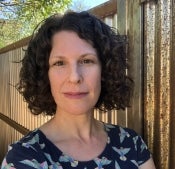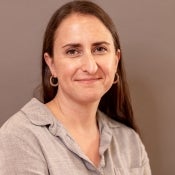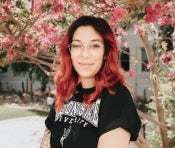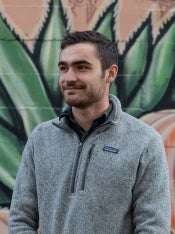ASU fellowship aims to engage Arizonans for a climate-friendly future

Image courtesy of iStock/Getty Images
The technologies that will frame life in the years to come can also deliver a more sustainable, equitable and just society. But building that positive future requires imagination, articulation and cooperation.
Arizona State University has been pursuing these goals for years and is now adding additional outside voices to the conversation, imagining thriving community futures powered by solar energy.
The Center for Science and Imagination and Center for Energy and Society launched the Solar Tomorrows Fellowship this past summer.
“As we engage the redesign of our energy system to make it clean, we should be asking, ‘What kind of future we are building for people and for the planet?’” said Clark Miller, director for the Center of Energy and Society and a professor with the College of Global Futures.
“The idea of this fellowship is to get the people of Arizona engaged in questions about how to build a climate-friendly future. Our state is going to be at the epicenter of solar energy development, and we have a lot of big questions on the table.”
The fellowship aims to help the people of the state learn more about and explore answers to those questions.
Thanks to a $50,000 grant from EarthShare, a Washington D.C.-based nonprofit, ASU was able to select four fellows with working experience in the realms of K–12 education, informal education, lifelong learning and journalism/popular media. The grant is part of EarthShare’s “The Energy of One, the Power of Many” program, which aims to raise awareness and foster support for sustainable energy initiatives.
The four Solar Tomorrows Fellows are: Annie Holub, high school teacher and journalist; Becky Pallack, journalist; Erika Perea, middle school teacher and advocate; and Anthony Wallace, journalist and podcast producer.
The four fellows worked for eight weeks in July and August 2023, oscillating between individual working time, weekly group meetings, one-on-one check-ins with ASU project leads and consultations with experts in solar energy and society, as well as learning and education across a variety of settings.
They were tasked with creating curriculum, teaching materials, educational media and interactive experiences to consider the role of solar energy in addressing the climate issue, how to deploy solar energy in Arizona and the implications of those choices, and the opportunities that solar energy technologies create to benefit state residents.
The materials they created were based on two books exploring a range of solar futures through fiction, essays and art — "The Weight of Light" (2019) and "Cities of Light" (2021) — both published by the Center for Science and the Imagination.
“Although they were designing learning materials for a diverse set of audiences, our fellows worked closely as a cohort. Their projects, which range from podcast episodes to classroom lesson plans, share themes and really feel like they’re in dialogue with one another,” said Joey Eschrich, who helped to coordinate the fellowship at the Center for Science and the Imagination.
“Our fellows also brought incredible insight to the challenge of actually reaching people with these visions of possible solar futures for Arizona, in ways that are personally motivating and culturally relevant.”
After eight weeks of intense brainstorming and collaboration, here’s what the four fellows came up with:
Annie Holub: High school narratives
Holub has 20 years teaching experience spanning multiple grade levels, from sixth grade to college. For the last decade, she has taught English at Tucson’s City High School, a charter school focused on place-based learning. This fall, she taught first-year writing at Pima Community College and is on the adjunct bench for ASU Digital Prep. She is also a former journalist, writing for the Tucson Weekly and Tucson Sentinel, as well as other national publications.
Among the many differences between Phoenix and Tucson, Holub believes the two cities are far apart when it comes to practicing sustainability.
“Kids grow up in Tucson having this intrinsic understanding of how to conserve water because of programs that have been in place for decades,” said Holub, whose father was an environmental attorney and mother worked in water conservation. “I come up here to Phoenix and I see lawns and say, ‘What is with all this grass, people?’ Conservation is very embedded in the culture of Tucson education.”
Holub would like to see Phoenix adopt that same fervor for a green future, which is why she has come up with a three-week, 15-day class session on sustainability for high schoolers in grades 9–12. She said students will read and write well-imagined narratives about a solar-powered future incorporating their ideas about geography, scale, ownership, governance, aesthetics, supply chain, waste and society.
“Science fiction and storytelling can help us imagine the future,” Holub said. “It’s a good thing for students to consider.”
Becky Pallack: Toolkit for journalists
Pallack is a Tucson-based journalist and the co-founder of Arizona Luminaria, an independent online news organization. She was previously a reporter at the Arizona Daily Star and an Arizona Press Club board member.
Journalists sometimes need a little help when it comes to learning about how to best cover sustainability issues, which is why Pallack has created an online resource/toolkit to help desert journalists understand complex topics surrounding solar energy and climate issues.
“We spent a lot of time talking to people in our communities engaged with this issue, and how they get their news on the environment,” Pallack said. “We learned that it’s very easy to get news at the national and world level, but how is climate change affecting us here in our Sonoran Desert home? It’s hard to get local information and sometimes it can be partisan or polarizing.”
Pallack’s toolkit provides readings, data and other resources for journalists about covering solar energy, energy policy and energy justice; unpacks common misconceptions about solar; provides ideas for how to engage local audiences with energy issues that might initially seem intimidatingly technical; identifies places to find experts to interview or consult with on stories; and more.
“Covering the climate is a collaboration organization of beat reporters who are trying to learn from one another,” Pallack said. “Instead of 50 journalists covering the same story, how can 50 journalists work together to cover bigger, better stories? Let’s bring some people together and see what happens.”
Erika Perea: Fun middle school activities
Perea is a volunteer with the Arizona Association for Environmental Education, advocating for environmental literacy. She currently teaches sixth grade in Mesa and is pursuing her master’s degree in elementary education at ASU.
Understanding sustainability can be a daunting proposition, especially for middle school students. That’s why Perea decided to go the fun route. She has created four activities to stimulate interest while creating an air of excitement.
The activities include conversation cards, a trivia game, story building blocks and a template for students to create their own zine — a mini-magazine where learners can share their feelings and insights about solar energy, futures thinking and engineering, based on teachings from "The Weight of Light" and "Cities of Light." The activities are designed both for classrooms and for use in informal learning settings, ranging from after-school programs and museums to at home around the kitchen table.
“These lessons can assess student background knowledge and engage them, then expose them to new vocabularies and ideas inspired by 'The Weight of Light' and 'Cities of Light,'” Perea said. “At the same time, they can reflect on what solar looks like in their own communities and what it means to be an advocate.”
Perea said by engaging in these activities, these students will not only learn about solar futures but improve their reading, analyzing, inference and solutions skills.
Anthony Wallace: Podcast episode for lifelong learners
Wallace is a journalist, podcaster and lifelong Arizonan. He produced two podcast series with KJZZ Phoenix, including "InHospitable," about Arizona’s most pressing environmental issues. His written work has been published in The Guardian, Associated Press and NPR.
In the last decade, podcasting has become a new way of digesting complex information and making it palatable to the reader. That’s the space where Wallace lives and breathes.
As the producer and host of NPR’s "InHospitable," Wallace focused on Arizona’s fight against drought, extreme heat and wildfire, as well as global problems affecting state residents and what is being done to solve them.
For his fellowship project, Wallace adapted a short story by Deji Bryce Olukotun from ASU’s book “Cities of Light,” creating an original podcast episode, “Solar Futures: The Scent of the Freetails.” In the podcast, actor Anthony Aroya performs a full reading of Olukotun’s short story, about a unique solar-powered community emerging in the suburbs of near-future San Antonio, Texas, and Wallace interviews experts who contributed to the story’s creation to discuss its vision for the future of community-level solar.
“What struck me about these stories (in 'The Weight of Light' and 'Cities of Light') was they were like sci-fi documentaries because they not only had stories but commentary from experts that helped create these universes,” Wallace said.
Wallace’s target audience is lifelong learners who enjoy learning with contextual information from experts. Specifically, he wants to engage enrolled members of Osher Lifelong Learning Institute and residents of Mirabella at ASU, and make his podcast part of their learning curriculum. To that end, he has also created a discussion guide to accompany the podcast, to guide conversations about its big ideas and vision for solar-powered communities of the future.
“It could stand in place of a book that they’d be assigned and then maybe we could gather together to talk about it,” Wallace said. “Perhaps Mirabella residents and students could participate together.”
Learn more about the fellowship and access the learning materials
More Environment and sustainability

Public education project brings new water recycling process to life
A new virtual reality project developed by an interdisciplinary team at Arizona State University has earned the 2025 WateReuse Award for Excellence in Outreach and Education. The national …

ASU team creates decision-making framework to improve conservation efficiency
Conserving the world’s ecosystems is a hard job — especially in times of climate change, large-scale landscape destruction and the sixth mass extinction. The job’s not made any easier by the fact…

Mapping the way to harvesting water from air
Earth’s atmosphere contains about 13 trillion tons of water.That’s a lot of water to draw upon to help people who are contending with drought, overtaxed rivers and shrinking aquifers.In fact,…





